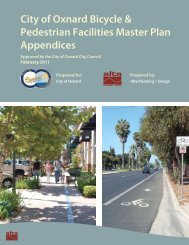Santa Clara River Trail Final Master Plan - Development Services ...
Santa Clara River Trail Final Master Plan - Development Services ...
Santa Clara River Trail Final Master Plan - Development Services ...
You also want an ePaper? Increase the reach of your titles
YUMPU automatically turns print PDFs into web optimized ePapers that Google loves.
Chapter 5: Benefit Cost Analysis<br />
The benefit-cost ratio weighs the anticipated annual benefits of the pathway against the estimated<br />
construction and maintenance costs for the pathway. The estimated construction cost for this project is<br />
$7.1 million. For benefit-cost analyses, construction costs incurred from 2011 to 2015 and annual<br />
maintenance and operating costs over 30 years are adjusted to net present value (NPV). Annual benefits<br />
(2011 dollars) were calculated based on high estimates, best estimates and low estimates for the number<br />
of bicycle commuters that would use the <strong>Santa</strong> <strong>Clara</strong> <strong>River</strong> <strong>Trail</strong>, following the NCHRP Report 552<br />
methodology for both 5 percent and 2.5 percent discount rates.<br />
Existing Count Data<br />
This analysis is informed by count data on trails in areas with similar climate and number of rideable<br />
days per year. This analysis assumes that walking and bicycling use on the <strong>Santa</strong> <strong>Clara</strong> <strong>River</strong> <strong>Trail</strong> will be<br />
similar to that of the Ballona Creek Path, which is a river path connecting to the beach at Marina del Ray,<br />
a popular recreation destination. The Los Angeles <strong>River</strong> Path is a regional trail system similar to the<br />
eventual nature of the <strong>Santa</strong> <strong>Clara</strong> <strong>River</strong> <strong>Trail</strong>.<br />
Count data are available from the Los Angeles County Bicycle Coalition’s 2009 Bicycle and Pedestrian<br />
Count and from counts conducted as part of the Culver City Bicycle and Pedestrian <strong>Master</strong> <strong>Plan</strong> (Draft<br />
2010). Counts are shown in Table 4.<br />
Table 4. Comparison of Pedestrian and Bicycle Counts on Similar <strong>Trail</strong>s<br />
Morning Peak Afternoon Peak Weekend Midday<br />
Location<br />
Ped Bike Ratio Ped Bike Ratio Ped Bike Ratio<br />
L.A. Bike Count<br />
Orange Line multi-use path<br />
Reseda & Orange Line 1244 104 12.0 N/A N/A N/A N/A N/A N/A<br />
Woodman & Orange Line 195 83 2.3 133 49 2.7 68 77 0.9<br />
LA <strong>River</strong> at Baum Bridge 48 110 0.4 46 164 0.3 11 95 0.1<br />
Ballona Creek N/A N/A N/A 181 353 0.5 421 1251 0.3<br />
Culver City Bicycle & Pedestrian <strong>Plan</strong><br />
Ballona Creel at Overland 34 63 0.5 31 94 0.3 81 285 0.3<br />
Ballona Creek Duquesne 36 51 0.7 N/A N/A N/A 7 107 0.1<br />
One of the purposes of this data is to determine the typical ratio of pedestrian to bicyclists, as the<br />
NCHRP Report 552 methodology considers only the increase in bicyclists on the trail. Assuming that the<br />
ratio of pedestrians to bicyclists will remain constant provides an estimate of future pedestrian use of the<br />
trail. Table 4 shows a significantly different ratio of pedestrians to bicyclists on the Orange Line multiuse<br />
path on other, non-transit-corridor trails. The ratios from the L.A. <strong>River</strong> <strong>Trail</strong> at Baum Bridge and<br />
along Ballona Creek are similar (ranging from 0.03 to 0.01). The average of those is used in this analysis.<br />
66 | Alta <strong>Plan</strong>ning + Design
















